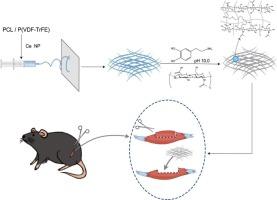静电纺P(VDF-TrFE)/二氧化铈纳米颗粒骨骼肌再生支架
IF 7.9
2区 材料科学
Q1 MATERIALS SCIENCE, MULTIDISCIPLINARY
引用次数: 0
摘要
由于骨骼肌的再生能力有限,体积性肌肉损失(VML)提出了一个重大的临床挑战。压电支架将机械信号转化为生物电信号,有望增强肌肉修复。在这项研究中,我们研究了由聚偏氟乙烯-三氟乙烯[P(VDF-TrFE)]和聚己内酯(PCL)组成的静电纺丝支架,在有或没有二氧化铈纳米颗粒(Ce NPs)的小鼠VML模型中的再生潜力。采用透明质酸功能化方法改善支架生物相容性。体外实验证实了这些支架的生物相容性,而超过8周的体内评估显示了恢复肌肉功能的显着功效。与PCL-Ce支架相比,植入压电支架的小鼠握力恢复更快,肌肉再生更成熟,肌纤维排列更分层,纤维直径增加。此外,Ce NPs的抗氧化特性减少了脂肪细胞的浸润和过多的胶原沉积,并与增强血管生成有关。握力测试进一步强调了P(VDF-TrFE)支架与Ce NPs结合的优越再生性能。总的来说,这些发现强调了与抗氧化剂结合的压电支架在促进VML后结构和功能肌肉再生方面的潜力。本文章由计算机程序翻译,如有差异,请以英文原文为准。

Electrospun P(VDF-TrFE)/ceria nanoparticle scaffolds for skeletal muscle regeneration
Volumetric muscle loss (VML) presents a significant clinical challenge due to the limited regenerative capacity of skeletal muscle. Piezoelectric scaffolds have shown promise in enhancing muscle repair by converting mechanical cues into bioelectric signals. In this study, we investigate the regenerative potential of electrospun scaffolds composed of poly(vinylidene fluoride-trifluoroethylene) [P(VDF-TrFE)] and polycaprolactone (PCL), with or without cerium dioxide nanoparticles (Ce NPs), in a VML mouse model. Hyaluronic acid functionalization was employed to improve scaffold biocompatibility. In vitro experiments confirmed the biocompatibility of these scaffolds, while in vivo assessments over eight weeks demonstrated significant efficacy in restoring muscle function. Compared with PCL-Ce scaffolds, mice implanted with piezoelectric scaffolds exhibited faster grip strength recovery, more mature muscle regeneration, a more hierarchical arrangement of muscle fibers, and increased fiber diameter. Additionally, the antioxidant properties of Ce NPs reduced adipocyte infiltration and excessive collagen deposition and were associated with enhanced angiogenesis. Grip strength measurements further highlighted the superior regenerative performance of P(VDF-TrFE) scaffolds combined with Ce NPs. Overall, these findings underscore the potential of piezoelectric scaffolds integrated with antioxidants in promoting structural and functional muscle regeneration following VML.
求助全文
通过发布文献求助,成功后即可免费获取论文全文。
去求助
来源期刊

Materials & Design
Engineering-Mechanical Engineering
CiteScore
14.30
自引率
7.10%
发文量
1028
审稿时长
85 days
期刊介绍:
Materials and Design is a multi-disciplinary journal that publishes original research reports, review articles, and express communications. The journal focuses on studying the structure and properties of inorganic and organic materials, advancements in synthesis, processing, characterization, and testing, the design of materials and engineering systems, and their applications in technology. It aims to bring together various aspects of materials science, engineering, physics, and chemistry.
The journal explores themes ranging from materials to design and aims to reveal the connections between natural and artificial materials, as well as experiment and modeling. Manuscripts submitted to Materials and Design should contain elements of discovery and surprise, as they often contribute new insights into the architecture and function of matter.
 求助内容:
求助内容: 应助结果提醒方式:
应助结果提醒方式:


